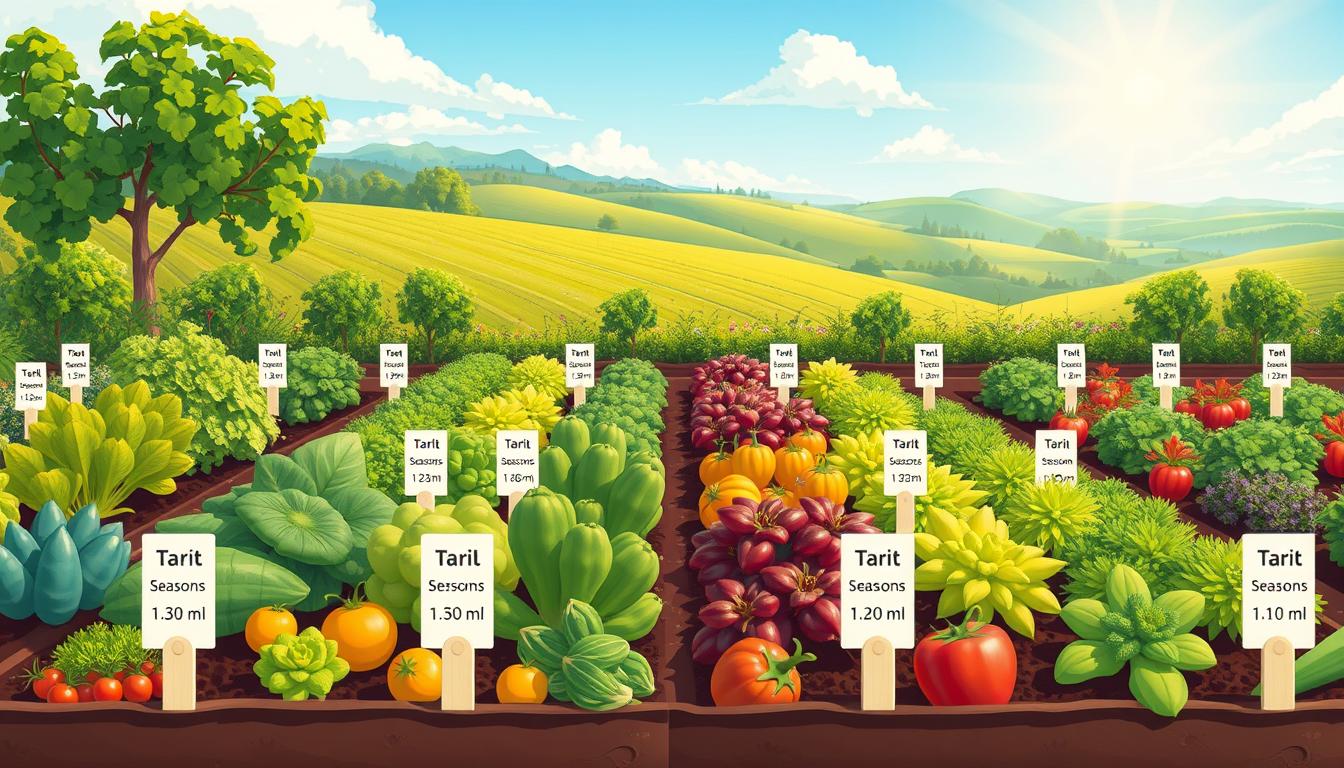Ever wonder why some gardens do well while others don’t? Timing is key. Knowing when to plant each crop can make a big difference.
Mother Nature has her own rhythm, and gardeners should follow it. This way, you’ll save time, reduce stress, and grow healthier plants with less work.
Whether you’re new to gardening or have been doing it for years, knowing the timing is crucial. Different plants do best in different seasons. What works in spring might not work in summer.
This guide will show you the best times for each season. We’ve got practical tips that fit your local growing conditions. Get ready to make your garden thrive all year round!
The Gardener’s Calendar: Understanding Nature’s Timing
A gardener’s calendar is more than a planning tool—it’s a way to work with nature’s cycles. Plants have evolved to respond to specific cues for growth, flowering, and seed production. By knowing these natural rhythms, you can plan your garden for the best results.
Successful gardening is about when you plant, not just what. Experienced gardeners know that timing is key. It determines if your plants will thrive or struggle.
Why Timing Matters in the Garden
Planting at the right time gives your garden a strong start. Soil temperature, day length, and moisture patterns all have specific times for different plants. Missing these times means fighting against nature, not with it.
Soil temperature is crucial for seed germination. Seeds need a certain temperature to grow. Plant too early or late, and they might not do well.
Day length also affects plants. Some plants bloom when days get shorter, others when they get longer. Regional weather patterns also guide when to plant.
How Plants Respond to Seasonal Changes
Plants have ways to sense and respond to seasonal changes. These adaptations help them grow and survive in the best conditions.
Some plants need cold to bloom. Others bloom based on day length. Short-day plants bloom when days get shorter, long-day plants when days get longer.
| Seasonal Factor | Plant Response | Gardening Implication | Example Plants |
|---|---|---|---|
| Day Length | Triggers flowering in many species | Affects planting schedules for optimal blooming | Chrysanthemums, poinsettias, lettuce |
| Soil Temperature | Controls germination rates | Determines earliest safe planting dates | Tomatoes, peppers, corn |
| Cold Exposure | Required for proper development | Necessitates winter planting for some species | Tulips, garlic, many fruit trees |
| Seasonal Rainfall | Triggers growth cycles | Influences watering needs and planting timing | Desert wildflowers, rice, seasonal vegetables |
Knowing how plants respond to nature helps you plan better. Instead of fighting nature, you can work with it. This leads to healthier plants and more harvests.
Essential Seasonal Planting Guides for Year-Round Success
Using seasonal planting guides can change your gardening game. These tools help you plan and predict your garden’s success. Whether you’re new or experienced, knowing how to use them can boost your gardening skills.
Types of Planting Calendars and Their Benefits
Today, gardeners have many seasonal planting guides to choose from. Paper calendars are easy to mark up and keep handy. Digital apps offer interactive features and weather updates.
Zone-specific guides help you plant based on your area’s climate. Crop-focused guides give detailed care for specific plants. These guides make planning easier.
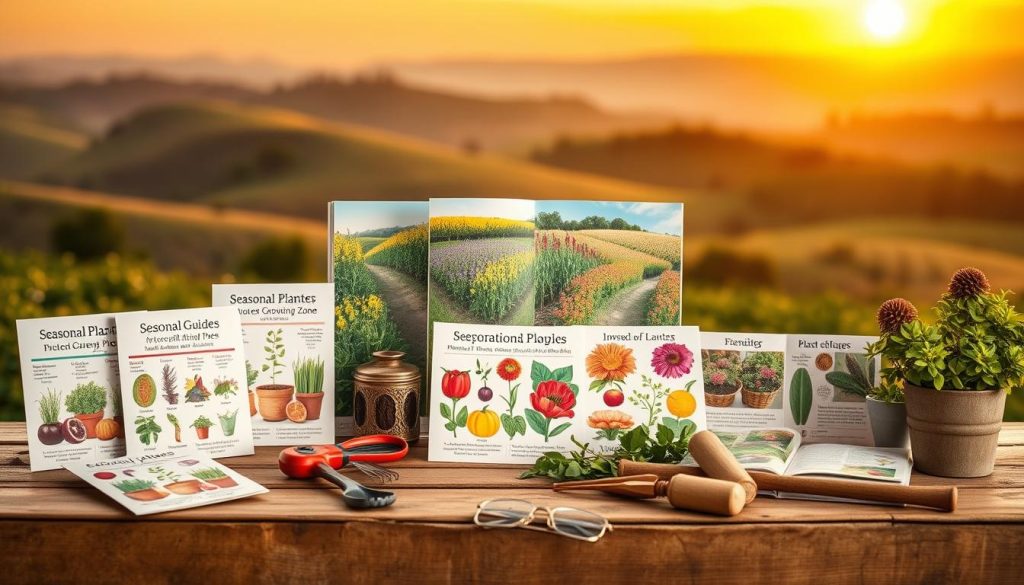
Perpetual calendars are great for long-term planning. Month-by-month guides break tasks into smaller steps. Visual timelines help you see planting windows clearly.
| Guide Type | Best For | Key Features | Limitations |
|---|---|---|---|
| Perpetual Calendars | Long-term planners | Reusable, comprehensive | Less specific to yearly conditions |
| Digital Apps | Tech-savvy gardeners | Notifications, weather integration | Requires device access |
| Zone-Specific Guides | Regional precision | Tailored to local climate | May not account for microclimates |
| Crop-Focused Timelines | Specialized growing | Detailed plant-specific advice | Less comprehensive for whole garden |
How to Read and Interpret Planting Guides
Understanding planting guides is key to gardening success. They use symbols and language that, once learned, are easy to read. Remember, these guides offer suggestions, not strict rules.
To use guides well, compare their advice with your garden’s needs. Look at planting times and soil temperature needs. This way, you can adapt the guides to your garden.
Understanding Symbols and Terminology
Planting guides use symbols like arrows for sowing and colored bars for transplanting. They also have icons for harvest times. Terms like “days to maturity” and “succession planting” are important to know.
“Hardening off” means getting seedlings ready for outdoor weather. “Cold stratification” is when seeds need a cold period to grow. Knowing these terms makes guides easier to follow.
Adapting Guides to Your Microclimate
Even the best guides can’t match your garden’s unique conditions. Things like elevation and wind can affect your garden differently. Keep track of your garden’s specific needs.
Record your garden’s frost dates and how they compare to the area’s. Notice how sun, wind, and drainage affect your garden. Use this info to adjust planting times for your garden’s needs.
Spring Planting: Awakening Your Garden
Spring is here, and it’s time to wake up your garden. This season offers many chances to plant different crops. Knowing when to plant helps your garden grow and gives you more food.
Early Spring Crops (March)
March starts the gardening year in many places. The soil is still cold, but it’s getting warmer. It’s the perfect time to plant cold-tolerant crops.
Cold-Hardy Vegetables
Cold-hardy veggies do well in the cool. Peas, spinach, and lettuce love the cold. Plant them when the soil is around 40°F.
Start planting these 4-6 weeks before the last frost. They’re great for your garden journal.
Spring Flower Bulbs and Perennials
Spring shows off bulbs like tulips and daffodils. It’s also a good time to move perennials. Plant hostas and peonies now for a strong start.
Mid-Spring Favorites (April)
April brings warmer weather and more planting options. This is the time for cool-season crops that need a bit warmer soil.
Brassicas like broccoli do well now. So do carrots and beets. Herbs like cilantro also thrive.
Start warm-season crops like tomatoes indoors. Start them 6-8 weeks before the last frost. This way, they’re ready to go outside when it’s warm.
Late Spring Transitions (May)
Late spring is when warm-season planting begins. Frost danger is over, and your garden can grow more. Check your planting schedule for your area.
When the soil is 60-65°F, it’s time for tomatoes and squash. Harden off seedlings before moving them outside.
Watch the soil temperature, not just the air. Use row covers for late frosts. This time bridges spring and summer, preparing for a bountiful season.
Summer Planting: Maximizing the Growing Season
Summer is a great time for gardeners to use hot-weather planting strategies. It’s not just for spring. By knowing the right vegetable sowing dates for summer, you can make your garden more productive.
Heat-Loving Vegetables (June)
June is the best time to plant heat-loving crops. Tomatoes, peppers, eggplants, and melons do well in the warm soil. Make sure to space them right to avoid fungal diseases.
Watering is key in June. Water the soil, not the plants, to prevent evaporation and disease. Watering in the morning helps plants dry before night, reducing fungal problems.
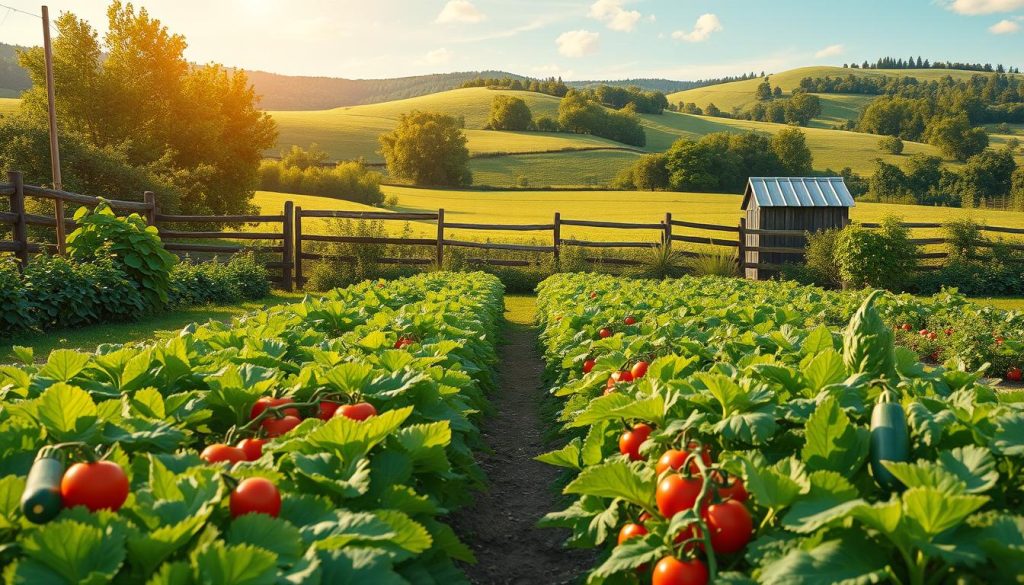
Use organic mulch to keep the soil moist and control weeds. Straw, shredded leaves, or compost are great options. They save you time on watering and weeding.
Mid-Summer Planting Opportunities (July)
July is a second chance for many crops, even in the heat. Bush beans, summer squash, and cucumbers can be direct-sown for a quick harvest. They mature in 45-60 days.
Heat-resistant greens like Swiss chard and New Zealand spinach are great in July. They provide fresh greens when traditional ones bolt. Choose varieties bred for summer.
Plant fast-growing crops like radishes and carrots every 2-3 weeks. This way, you get a steady harvest instead of a big batch all at once. It’s a smart way to use your garden space.
Planning for Fall While in Summer (August)
August is a time to start planning for fall. Begin growing broccoli, cabbage, and kale indoors. They’ll be ready for transplanting in September when it cools down.
Direct-sow cool-season crops like spinach and peas in shaded areas. The warm soil and shade are perfect for them.
Summer is also the time to review your garden’s performance. Plan your crop rotation for next year. Keep a garden journal to help with next year’s planning.
Fall Planting: Extending Your Harvest
Fall’s mild weather and fewer pests make it a great time to garden. Many gardeners miss the chance to grow a second season after summer crops finish. With the right planning, you can keep enjoying fresh food into winter and get your garden ready for spring.
Cool-Season Crops (September)
September is the best time to plant cool-season veggies. These plants get sweeter when it’s a little chilly.
Plan your planting by counting back from your area’s first frost date. Most fall veggies need 30-90 days to grow big enough to eat.
- Leafy greens: spinach, kale, lettuce, arugula, mustard greens
- Root vegetables: radishes, turnips, carrots, beets
- Brassicas: broccoli, cauliflower, cabbage, Brussels sprouts
- Peas: snow peas and sugar snap varieties
Fall’s cooler nights and shorter days help these crops grow better. They also face fewer pests as the weather cools down.
Preparing for Winter (October)
October brings the first frost, so protect your plants. It’s also a good time to plant for next year’s harvest.
Use row covers, cold frames, and cloches to keep plants warm. These simple tools can make your garden 5-10 degrees warmer, helping plants grow longer.
October is perfect for planting garlic and shallots for summer. These need cold to grow well. Just plant the cloves 2-3 inches deep, with the pointed end up, and cover with mulch.
Adding cover crops like winter rye and hairy vetch is key. They keep the soil from washing away and add nutrients. They’re vital for a sustainable garden.
Last Chances Before Frost (November)
November is your last chance to plant before winter. Focus on crops that can handle cold, like spinach and kale.
These hardy plants can go dormant in the cold and grow again in winter thaws. With the right care, you might have fresh greens in January!
Winter Protection Strategies
As it gets colder, protect your winter crops. Start with row covers, then add hoops and plastic for more warmth. On very cold nights, cover with cardboard or blankets. Remove these on sunny days to avoid disease.
Mulching and Soil Preparation
Fall is great for improving your soil. Add compost and manure that will break down over winter. Use leaves, straw, or paper as mulch to keep the soil warm and prevent weeds. When spring comes, your soil will be ready for new plants.
Winter Planting: The Overlooked Season
Winter is not a time to stop gardening. It’s a chance to grow indoors and prepare for spring. You can keep growing and get ready for a great spring.
Indoor Growing Projects
Turn your windowsills and countertops into growing spaces in winter. Microgreens are quick to grow, ready in 7-14 days. They’re packed with nutrients and need just a shallow container, good soil, and light.
Sprouts grow fast, needing no soil. Just a jar, water, and daily rinsing. For fresh herbs, try an indoor garden near a sunny window. Basil, chives, and mint do well indoors with little setup.
If light is scarce, LED grow lights can help. Many gardeners grow well indoors with simple setups and lights. They get great harvests in winter without fancy gear.
Winter Sowing Techniques
Winter sowing uses nature to grow strong seedlings easily. It uses recycled containers like milk jugs as mini-greenhouses. Seeds get cold stratification outdoors while staying protected.
To make a winter sowing container, cut a milk jug in half, add drainage holes, fill with soil, plant seeds, and tape it shut. Label it and place it outside where it gets rain.
Good plants for winter sowing include native perennials, hardy annuals, and cool-season veggies. They grow well with winter’s cycles, matching your local gardening timeline.
Planning and Preparation for Spring
Winter is a great time to review your garden’s past year. Look at notes, photos, and memories to see what worked and what didn’t.
January is the best time to order seeds before they sell out. Seed companies release new catalogs at the start of the year. Use this time to plan your garden, including crop rotation and planting schedules.
Don’t forget to maintain your tools in winter. Clean, sharpen, and oil them to keep them in good shape for spring. This is also a good time to fix raised beds and trellises before planting starts again.
Fruit Tree and Perennial Planting Seasons
Starting a garden with fruit trees and perennials is exciting. But, you need to know when to plant them. Unlike veggies that grow and die in a year, these plants live longer. They need the right time to plant to grow well for years.
Deciduous Fruit Trees: When to Plant for Best Results
The best time to plant deciduous fruit trees is when they’re dormant. This is usually late fall to early spring. This lets them grow strong roots before they need to grow leaves and fruit.
Planting in fall (October to November) is great for many areas. The soil is still warm, but the air is cooler. By spring, these trees are ready to grow leaves and fruit.
In places with cold winters, spring planting (February to April) is better. You can choose between bare-root or container-grown trees. Bare-root trees are cheaper and grow fast when planted in the right season.
Berry Bushes and Vines: Seasonal Timing
Berry plants need different planting times. Strawberries do best in early spring. This lets them grow before they produce fruit the next year. June-bearing strawberries will have their first big harvest in June.
Blueberries can be planted in fall or spring. In warmer areas, fall planting is best. In colder places, spring planting is better after the soil warms up.
Raspberries and blackberries do best in early spring. This helps their shallow roots grow before summer heat. Grapes are also best planted in early spring, when they’re dormant.
Perennial Vegetables and Herbs: Establishment Timing
Perennial veggies are valuable but often overlooked. Asparagus crowns should be planted in early spring. This lets them grow all season before winter.
Rhubarb and artichokes also do well in spring. Their roots grow during the season, preparing them for harvests later. In cold areas, plant artichokes after the frost is gone.
Herbs like rosemary, thyme, and sage do best in early fall. This lets them grow roots before summer. In cold areas, plant them in early spring to get a head start.
Regional Adaptations: Customizing Your Planting Schedule
The United States has many different places to grow plants. What works in California might not work in Minnesota. Knowing these differences helps you garden better.
Regional gardening guides give advice for your area. They consider local weather, soil, and weather events. This way, you can plan your garden to grow well.
USDA Hardiness Zones Explained
The USDA Hardiness Zone map shows 13 zones in North America. Each zone is 10°F different. Zone 1 is the coldest, and Zone 13 is the warmest.
But, hardiness zones only show cold tolerance. They don’t tell about summer heat, rainfall, or growing season length. Use the USDA’s map or ask your local office for the best info.
Northeast and Midwest Considerations
Gardeners in the Northeast and Midwest have short growing seasons. Cold winters and variable springs delay planting. Late frosts can end the season early.
To grow well, try these tips:
- Start seeds indoors 6-8 weeks before last frost
- Use cold frames and row covers to extend seasons
- Choose quick-maturing varieties for main crops
- Plant cool-season crops both in spring and fall
Southern Growing Advantages and Challenges
Southern gardeners have longer growing seasons and milder winters. But, they face hot summers, high humidity, and pests. Spring and fall are the best times to grow many crops.
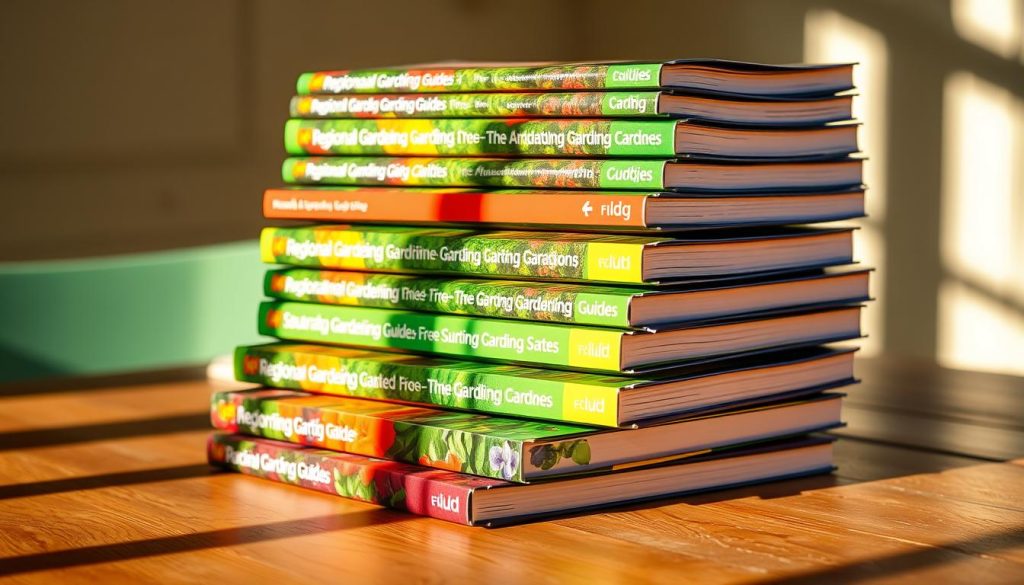
Winter gardening works for cool-season crops in the South. For summer, choose plants that can handle heat and drought.
Western and Pacific Northwest Strategies
The West has everything from deserts to coastal areas. The Pacific Northwest is cool and wet, great for leafy greens but tough for tomatoes.
California’s climate lets you grow plants all year in many places. Mountain areas have short seasons with big temperature changes. In dry areas, save water and choose plants that don’t need much water.
| Region | Growing Season Length | Key Challenges | Recommended Strategies |
|---|---|---|---|
| Northeast/Midwest | 4-6 months | Short seasons, cold winters | Season extension, cold-hardy varieties |
| Southeast | 7-9 months | Summer heat, humidity, pests | Heat-tolerant varieties, fall/spring focus |
| Southwest | 8-12 months | Drought, intense sun, poor soil | Drought-resistant plants, shade cloth |
| Pacific Northwest | 6-8 months | Limited sun, excess moisture | Raised beds, mildew-resistant varieties |
Local extension offices and community gardeners offer great advice. They know about local weather and soil. Use their tips with your hardiness zone to make a plan that works for your garden.
Succession Planting: Maximizing Garden Space and Yield
Succession planting is the key to a bountiful harvest. It keeps your garden productive all season long. Instead of planting once, you sow and harvest in a cycle. This method boosts your garden’s yield and keeps your table full of fresh food.
Planning Your Succession Strategy
Planning is the first step in successful succession planting. You need to consider your garden’s conditions and what you want to harvest. There are three main ways to plan your garden.
- Same-crop succession: Plant the same vegetable every 2-3 weeks for a steady supply (great for lettuce, radishes, and spinach)
- Crop-to-crop succession: Plant a new crop right after harvesting the old one (like peas followed by beans)
- Relay planting: Start the next crop before the current one is done (such as planting squash between rows of nearly-finished lettuce)
When planning, think about your growing season, available space, and what your family likes. Map out your garden and make a schedule for each crop’s growth. Remember to add compost between plantings to keep the soil rich.
Quick-Growing Crops for Succession
Some vegetables grow fast and are perfect for succession planting. They allow for many harvests from the same spot all season.
- Radishes: Ready in just 21-28 days, making them perfect for multiple successions
- Salad greens: Leaf lettuce, arugula, and spinach can be harvested in 30-45 days
- Bush beans: Produce within 50-60 days and can be planted every 2-3 weeks
- Baby root vegetables: Beets, turnips, and carrots harvested young (30-40 days)
- Asian greens: Bok choy and tatsoi mature in about 45 days
For ongoing harvests, plant these fast-growing crops in small batches. Most can be sown every 2-3 weeks. Watch out for temperature changes, as cool-season crops like lettuce and radishes do best in spring and fall.
Record-Keeping for Future Success
Keeping a garden journal turns each season into a learning experience. Record planting dates, varieties, weather, and harvests. This info gets more valuable over time, helping you improve your garden plans.
Notes on which plantings did well and which didn’t will help plan for next year. Include notes on pests, weather, and variety performance. This builds a personalized guide that gets better with each season.
Digital Tools for Garden Planning
Today’s gardeners have digital tools to help with succession planting. Apps like Planter, Seed to Spoon, and Garden Plan Pro create customized schedules based on your location. They send reminders for sowing and track your garden’s progress. Even a simple spreadsheet can organize your planting schedule, with tabs for each season or bed.
Creating Your Personal Planting Calendar
Use your garden records and local frost dates to make a personalized planting calendar. Start with a yearly view that shows key planting times for succession crops. Use colors for different plant families or seasons. Update it every year with new lessons and timing adjustments. This evolving calendar is your most valuable tool, tailored to your garden’s needs.
Climate Change and Seasonal Planting: Adapting to New Realities
Climate change is changing how and when we garden. We need new ways to plan our planting. The old patterns are gone, and new ones are hard to find.
Today’s gardeners must be flexible and ready to adapt. We need to use nature’s rhythms but also be open to change.
Shifting Growing Seasons
In the U.S., growing seasons are changing. Spring comes earlier, and fall lasts longer. This means we can grow plants for more months.
But, there are challenges too. Early warm spells can hurt fruit trees. Gardeners must watch the weather closely, not just the calendar.
Using weather stations and soil temperature is key. Watching when plants bloom helps us know when to plant.
Drought and Heat Adaptations
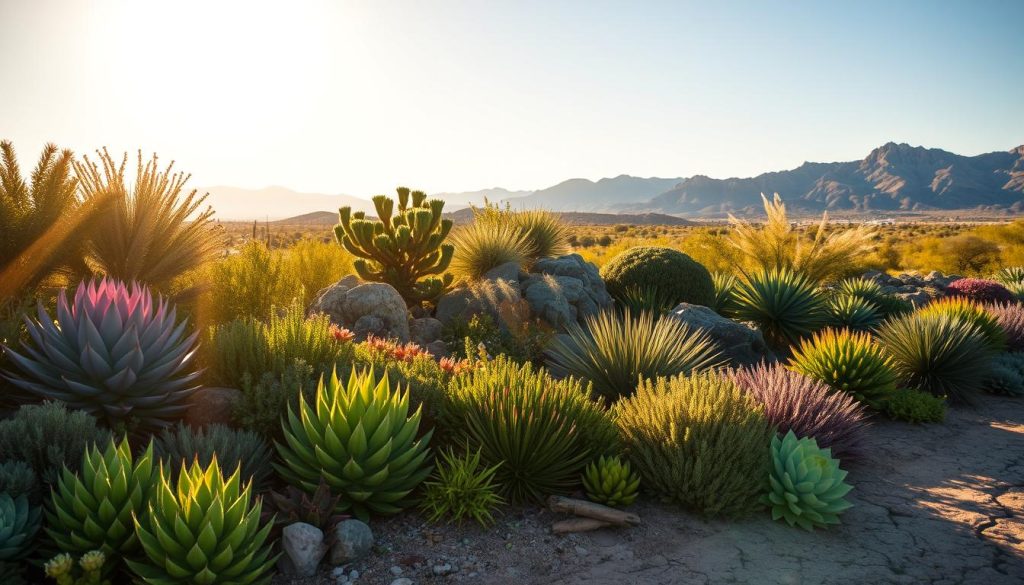
Hotter temperatures and unpredictable rain need new garden plans. We plant warm-season crops earlier or later to avoid heat damage.
Watering wisely is crucial. Deep, less frequent watering and mulching help plants survive dry spells. We plant when it rains, helping roots grow strong.
Choosing heat-tolerant plants is smart. Many seed companies now offer these varieties for our changing climate.
Resilient Planting Strategies
Building a resilient garden helps it weather unpredictable weather. Growing different crops together creates a protective environment.
Planting in batches helps spread out risks. If one batch fails, others might still grow. This way, we can still have a harvest.
Adding perennial plants to our gardens helps too. They are more resistant to extreme weather. By observing our local climate, we can make our gardens more resilient.
Cultivating Year-Round Garden Joy: Beyond the Calendar
Seasonal planting guides connect us to ancient farming traditions. They remind us of natural cycles we often forget in our busy lives.
Each season offers unique gardening joys. Spring brings the excitement of new growth. Summer rewards us with fresh produce. Fall is about preserving and preparing for rest. Winter is for dreaming and planning.
The best gardeners see planting guides as starting points, not rules. Your garden’s patterns depend on your location, climate, and soil.
As you follow these guides, observe what works best in your garden. Notice which plants thrive, when your soil warms, and where the sun shines.
Keep simple notes on planting dates and results. These records will become your most valuable gardening tools over time.
Remember, “garden failures” teach us valuable lessons. That failed tomato taught you something about your garden’s conditions.
The true joy of gardening is the ongoing relationship with your land. By working with nature’s rhythms, you’ll create a garden that satisfies you all year.

